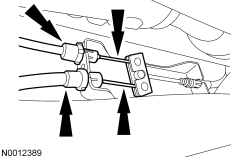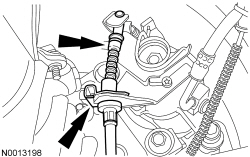SECTION 206-05: Parking Brake and Actuation
| 2014 Mustang Workshop Manual
|
DIAGNOSIS AND TESTING
| Procedure revision date: 01/07/2013
|
Parking Brake
Principles of Operation
Parking Brake System
The parking brake system is cable-actuated and controlled by an independent hand-operated parking brake control that is not self adjusting, The parking brake system is actuated when the parking brake control is pulled up. When the parking brake control is pulled, tension is applied to the front parking brake cable. This tension pulls on both rear parking brake cables, which are attached to the brake caliper parking brake actuators and apply the brake pads. When the parking brake release button is pressed and the brake control is released, the return springs on the brake calipers and the parking brake control return the system to the released position.
Inspection and Verification
NOTE:
Prior to carrying out any diagnosis, make sure the red brake warning indicator is functional. Refer to
Section 413-01
.
The first indication that something may be wrong in the brake system is a change in the feeling through the parking brake control. The parking brake not holding on an incline or dragging after being released are also indicators of system concerns.
Check the operation of the parking brake system with the vehicle on a hoist and the parking brake control fully released. Check for any damaged cables and install new components as necessary. Carry out the brake system diagnosis.
- Verify the customer concern.
- Visually inspect for obvious signs of mechanical damage.
Visual Inspection Chart
| Mechanical
|
|---|
- Front parking brake cable and conduit
- Parking brake control
- Parking brake equalizer
- Rear brake calipers
- Rear parking brake cables and conduits
|
- If an obvious cause for an observed or reported concern is found, correct the cause (if possible) before proceeding to the next step.
- If the cause is not visually evident, verify the symptom and GO to
Symptom Chart
.
Symptom Chart
Symptom Chart
| Condition
| Possible Sources
| Action
|
|---|
- The red brake warning indicator is always/never on
| - Brake fluid level switch
- Parking brake switch
- Wiring, terminals or connectors
- Instrument Cluster (IC)
- Smart Junction Box (SJB)
| |
| - Parking brake component(s)
| - INSPECT the parking brake system for corrosion, rust or kinked cables. REPAIR or INSTALL new parking brake components as necessary.
|
| - Rear brake caliper guide pins
| - INSPECT the brake caliper guide pins. REFER to Brake Caliper Guide Pins in
Section 206-00
.
|
| | - INSPECT the brake caliper guide pins. REFER to Brake Caliper in
Section 206-00
.
|
| | |
| | - CARRY OUT the Brake Master Cylinder Component Test. REFER to
Section 206-00
.
|
- The parking brake will not apply
| - Parking brake control
- Parking brake cables
- Parking brake rear wheel components
| |
- The parking brake will not release
| - Parking brake cables
- Parking brake control
- Parking brake rear wheel components
| |
Pinpoint Tests
Pinpoint Test A: The Parking Brake Will Not Apply
Normal Operation
The parking brake system is cable actuated and controlled by an independent hand-operated parking brake control that is not self adjusting. The parking brake system is actuated when the parking brake control is pulled up. When the parking brake control is pulled, tension is applied to the front parking brake cable. This tension pulls on both rear parking brake cables, which are attached to the brake caliper parking brake actuators and apply the brake pads.
This pinpoint test is intended to diagnose the following:
- Parking brake control
- Parking brake cables
- Rear brake calipers
PINPOINT TEST A: THE PARKING BRAKE WILL NOT APPLY
| Test Step
| Result / Action to Take
|
|---|
|
A1 CHECK THE PARKING BRAKE CONTROL
|
|
- Apply the parking brake control.
- Does the parking brake control move?
| Yes
GO to
A2
.
No
GO to
A3
.
|
|
A2 CHECK FOR BROKEN CABLES
|
|
- NOTE:
Have an assistant apply and release the parking brake control to help isolate disconnected cables or cables that do not move.
- Inspect the following items for damage and correct connections:
- Rear brake caliper actuators
- Is any damage found or are any components disconnected?
| Yes
CONNECT the component(s) or INSTALL a new parking brake component(s) as necessary. TEST the system for normal operation.
No
VERIFY that the rear pads are within thickness specifications. REFER to Specifications in
Section 206-00
. If the rear pads are OK, INSTALL new rear brake calipers. REFER to
Section 206-04
.
|
|
A3 ISOLATE THE PARKING BRAKE CONTROL AND FRONT PARKING BRAKE CABLE
|
|
- Disconnect the LH and RH rear cables from the equalizer and release the cables from the body bracket.
 - Apply the parking brake control.
- Does the parking brake control move?
| Yes
GO to
A4
.
No
INSTALL a new parking brake control. REFER to
Parking Brake Control
in this section. TEST the system for normal operation.
|
|
A4 ISOLATE THE REAR PARKING BRAKE CABLES
|
|
- Disconnect the LH and RH parking brake cables from the subframe brackets and the brake calipers.
 - While holding the cable conduit, attempt to slide the cable inside the conduit.
- Does the cable slide freely inside the conduit?
| Yes
INSTALL new rear brake calipers. REFER to
Section 206-04
.
No
INSTALL a new rear brake cable(s). REFER to
Parking Brake Cable — Rear
in this section. TEST the system for normal operation.
|
Pinpoint Test B: The Parking Brake Will Not Release
Normal Operation
When the parking brake release button is pressed and the brake control is released, the return springs on the brake calipers and the parking brake control return the system to the released position.
This pinpoint test is intended to diagnose the following:
- Parking brake cables
- Parking brake control
- Parking brake rear wheel components
PINPOINT TEST B: THE PARKING BRAKE WILL NOT RELEASE
| Test Step
| Result / Action to Take
|
|---|
|
B1 CHECK THE PARKING BRAKE CONTROL
|
|
- Press the release button on the parking brake control and release the handle.
- Does the parking brake control move?
| Yes
GO to
B2
.
No
INSTALL a new parking brake control. REFER to
Parking Brake Control
in this section. TEST the system for normal operation.
|
|
B2 CHECK THE REAR PARKING BRAKE CABLES
|
|
- Disconnect the LH and RH rear cables from the equalizer and release the cables from the body bracket.
 - Disconnect the LH and RH parking brake cables from the subframe brackets and the brake calipers.
 - While holding the rear cable conduit, attempt to slide the rear cable inside the conduit.
- Does the cable slide freely inside the conduit?
| Yes
INSTALL new rear brake calipers. REFER to
Section 206-04
.
No
INSTALL new rear brake cable(s). REFER to
Parking Brake Cable — Rear
in this section. TEST the system for normal operation.
|

